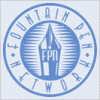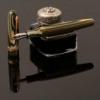Dearest members of the digital fountain pen nut house,
It has been several weeks already since shipping started, and many of the FPN LE Passportos in Chrome trim and in Gold Coloured trim have been collected by DHL in the beautiful town of Florence in Italy and have found their way to their respective new owners. For a few pictures of these pens, you can check here: http://www.fountainp...to-on-the-road/, or obviously in the FPN Pens forum. The Modello-Ts and Etrurias are expected to start shipping this week.
A few useful, we hope, tips follow here, based on questions we received so far.
1. Removal/Exchange of Passaporto nibs.
We've had a few questions regarding exchanging the nib units on the Passaportos, as those proved rather hard to remove, and we now have nib exchange / removal instructions which work very well, thanks to inkspot and Maja, who simultaneously and independently discovered the way to do this!
The nib itself can be removed and replaced quite easily, all you need is something to increase your grip, like a piece of flexible rubber matting, and if you have a good grip with your fingers, it may even be possible to do this just with one's bare hands. I gave it a go with a thin, rubber, flexible mouse mat, and it worked like a charm!
Essentially, the trick is to grip the sides of the nib, by the shoulders, with the rubber mat in my case, and just pull. You may have to wriggle a little, but the nib will come out quite easily that way, leaving the feed in place. I didn't have to wriggle, BTW, I could just pull it out quite easily in a straight line.
Next pull the nib from the nib unit you'd like to install, and insert that nib by pushing it up over the feed, all the way as far as it will go, again using the rubber matting for increased grip (and to avoid ending up with a nib point in one's skin ![]() ). Just check that it is seated properly, tight to the feed, and adjust if necessary.
). Just check that it is seated properly, tight to the feed, and adjust if necessary.
That's all, easy-peasy. Took less than a minute to do. And because it is a tight fit, I reckon it is almost impossible to get it wrong. ![]()
2. Shipping info and tracking numbers.
We send out emails with tracking numbers and a link to the DHL site in order to follow the shipping trail. Essentially, these emails contain a personalized note, with the tracking number for your order, and a url, and they are sent from info@fountainpennetwork.com, which is a no-reply email address created for exactly this type of message.
If messages from FPN end up in your regular mailbox, these should too, but if they don't, better check your spam folder.
3. Passaporto nib sizes.
The Passaporto F and M nibs tend to be a little on the narrow side compared to "regular" European nib sizes, more like Japanese nibs, maybe slightly bigger. Furthermore, as Etruria S.r.l. indicated when asked, there is some variation in nib width, as is the case with all nibs anyway. However, from all accounts they do write very, very smoothly, and quite impressively so based on comments received so far.
Having said this, the 1.1 italic nibs are true to size, they really lay down a 1.1 mm wide vertical stroke. This is typical for all Stipula italic nibs: the line laid down is indeed as wide as it says in the descriptive nib name ![]() .
.
4. Initial starting problems / rinsing and priming a nib and feed.
New pens, especially hand made ones like the Stipulas, may have some residual grease in the feed etc. when coming straight from the box, and as a result may start with difficulty initially.
The best thing to do obviously is to remove any residu, and this can be done quite easily, by rinsing the nib and feed with a soapy solution. A soapy solution is essentially a smallish glass filled with some water and one to two drops of a neutral dishwashing liquid, stirred, not shaken ![]() . A neutral dishwashing liquid is one without additives like perfumes and skin softeners etc. Generally, the cheapest available will do very nicely.
. A neutral dishwashing liquid is one without additives like perfumes and skin softeners etc. Generally, the cheapest available will do very nicely.
Rinsing the nib and feed can be done most easily when the pen is a piston filler, or in case of Passaporto or Modello-T, with a converter, international size. Just insert the converter in the pen, and in case of the Passaporto it doesn't matter that the size of the converter is too big to screw on the barrel, because we will not do that anyway. Next fill the pen through the nib with the soapy solution and squirt the solution out again, into the sink or into another glass. Repeat this a few (2-4) times, remove converter if appropriate, and dry the nid/feed/pen a little, with a soft cloth or tissue.
Now fill the pen with a few drops of a simple ink, which flows well and has good lubrication characteristics. The amount roughly contained in a single short international cartridge is ample for this purpose. A simple ink as described, is f.e. Waterman Blue Black, Waterman Florida Blue, or Waterman South Seas Blue. I use such an ink to, what I have called several years ago, "priming the feed", i.e., somehow get the ink channels and feed itself thoroughly soaked in a good ink, thereby "priming" it to be used with any other, potentially more complex ink thereafter. The big advantage is that an ink as mentioned will make the initial writing process a pleasant one, whereas a complex, heavily saturated ink will potentially make this an arduous task. Complex inks often take several fills to prime a nib, and during that period one may experience a lot of skipping and slow or bad starting. Based on my own tests this proved to be anything from 2 to 15 cartridges full of ink (that is without rinsing the nib and feed as well). Priming a feed with a well behaved, simple ink avoids this, and sets the pen up for a more complex ink thereafter.
5. Increasing ink flow / making the nibs write wetter.
The Passaporto nibs are medium wet writers, with rather tightly spaced tines, writing relatively thin lines as a result. Increasing ink flow is possible, but this needs to be done properly in order not to change nib geometry and potentially cause problems, like ink pooling.
The best way to increase ink flow, is to use a brass feeler gauge, thickness 0.002 " or 0.05 mm. By lack of this, a piece of a thin transparant overhead sheet may be used as well. Just wriggle this between the nib tines and tipping, if need be by carefully pushing one of the tines down or up a tiny bit with a finger nail, and slowly but carefully pulling the feeler gauge or piece of sheeting between the tines and tipping ends, essentially carefully flossing the nib if you like.
Repeat this process until ink flow is as expected. IOW between attempts you need to try if the result is satisfactory. If it appears that the feeler gauge is too thin to achieve the desired effect, you may want to try a 0.004 " or 0.10 mm gauge.
In case you don't have or can't find a brass feeler gauge, you may try a stainless steel one, just be very careful, as stainless steel is much tougher and harder than brass, and may more easily damage nib tipping, or scratch the nib.
6. Reporting problems with your pen(s)
If e.g., skipping cannot be fixed by rinsing the pen, or anything else for that matter, do report this to undersigned, by means of a PM, or preferably an email (check my profile to send an email), and we will try to answer as quickly as possible, and/or follow this up with Etruria S.r.l. where and if needed.
So far this update, and a few tips. If you do have tips yourself, please do post them, they are always appreciated.
Warm regards, Wim
On behalf of the FPN Admin Team




49 Comments
Recommended Comments
Create an account or sign in to comment
You need to be a member in order to leave a comment
Create an account
Sign up for a new account in our community. It's easy!
Register a new accountSign in
Already have an account? Sign in here.
Sign In Now